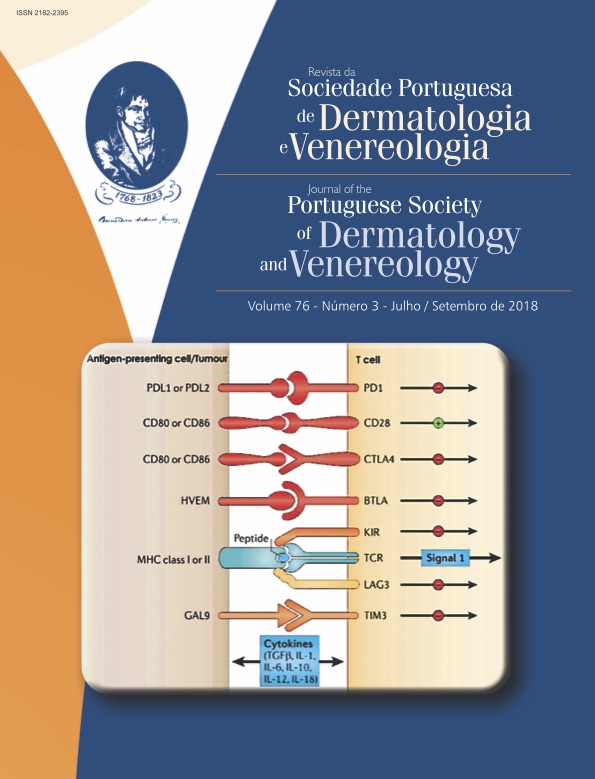Necrólise Epidérmica Tóxica Induzida pelo Vemurafenib: Um Efeito Adverso Emergente
Resumo
O vemurafenib, um inibidor seletivo da mutação BRAF V600, está aprovado pela Food and Drug Administration (FDA) e European Medicines Agency (EMA) para o tratamento de melanoma metastático em estadio IV isoladamente ou em combinação. De entre os efeitos adversos, a toxicidade cutânea é a mais comum. A maior parte destas reações, como o eritema, a fotossensibilidade e as lesões hiperqueratósicas, são facilmente controladas podendo a maioria dos doentes continuar terapêutica. Contudo, têm sido descritos alguns casos de reações cutâneas graves com risco de vida e necessidade de suspensão terapêutica. Os autores reportam um caso de necrólise epidérmica tóxica induzida pelo vemurafenib num doente a efetuar tratamento para melanoma metastizado. Após várias complicações hospitalares, o doente sobreviveu à reação provocada pelo fármaco e encontra-se em remissão há 2 anos.
Downloads
Referências
Chapman PB, Hauschild A, Robert C, Haanen JB, Ascierto
P, Larkin J, et al. Improved survival with vemurafenib in
melanoma with BRAF V600E mutation. N Engl J Med.
;364:2507–16. doi: 10.1056/NEJMoa1103782.
Gençler B, Gönül M. Cutaneous side effects of BRAF
inhibitors in advanced melanoma: Review of the literature.
Dermatol Res Pract. 2016;2016:1–6. doi:
1155/2016/5361569.
Peuvrel L, Quéreux G, Saint-Jean M, Brocard A, Nguyen
JM, Khammari A, et al. Profile of vemurafenib-induced
severe skin toxicities. J Eur Acad Dermatol Venereol.
;30:250–7. doi: 10.1111/jdv.13443.
Sinha R, Edmonds K, Newton-Bishop JA, Gore ME, Larkin
J, Fearfield L. Cutaneous adverse events associated with
vemurafenib in patients with metastatic melanoma: practical
advice on diagnosis, prevention and management of
the main treatment-related skin toxicities. Br J Dermatol.
;167:987–94. doi: 10.1111/bjd.12010.
McArthur GA, Chapman PB, Robert C, Larkin J, Haanen
JB, Dummer R, et al. Safety and efficacy of vemurafenib
in BRAFV600E and BRAFV600K mutation-positive melanoma
(BRIM-3): extended follow-up of a phase 3, randomised,
open-label study. Lancet Oncol. 2014;15:323–32.
doi: 10.1016/S1470-2045(14)70012-9.
Sinha R, Lecamwasam K, Purshouse K, Reed J, Middleton
MR, Fearfield L. Toxic epidermal necrolysis in a patient
receiving vemurafenib for treatment of metastatic malignant
melanoma. Br J Dermatol. 2014;170:997–9. doi:
1111/bjd.12796.
Jeudy G, Dalac-Rat S, Bonniaud B, Hervieu A, Petrella T,
Collet E, et al. Successful switch to dabrafenib after vemurafenib-
induced toxic epidermal necrolysis. Br J Dermatol.
;172:1454–5. doi: 10.1111/bjd.13522.
Wantz M, Spanoudi-Kitrimi I, Lasek A, Lebas D, Quinchon
J-FJ-F, Modiano P. Necrolyse epidermique toxique au vemurafenib.
Ann Dermatol Vénéréol. 2014;141:215–8.
doi: 10.1016/j.annder.2013.10.054.
Lapresta A, Dotor A, González-Herrada C. Toxic epidermal
necrolysis induced by vemurafenib. Actas Dermosifiliogr.
;106:682–3. doi: 10.1016/j.ad.2015.03.008.
Arenbergerova M, Mrazova I, Horazdovsky J, Sticova E,
Fialova A, Arenberger P. Toxic epidermal necrolysis induced
by vemurafenib after nivolumab failure. J Eur Acad
Dermatology Venereol. 2017;31:e253–4. doi: 10.1111/
jdv.14010.
Kılıç S, Özkaya E, Baykal C, Vatansever S. Vemurafenib-
-induced toxic epidermal necrolysis: Is it an emerging side-
effect of the drug? J Eur Acad Dermatology Venereol.
;31:e354–5. doi: 10.1111/jdv.14150.
Ling-He Meng JZ, Meng LH, Zhang LT, Yu GX. Cytokines
induced skin adverse reactions. J Clin Exp Dermatol Res.
;5.
Guillot B, Blazquez L, Bessis D, Dereure O, Guilhou JJ.
A prospective study of cutaneous adverse events induced
by low-dose alpha-interferon treatment for malignant
melanoma. Dermatology. 2004;208:49–54. doi:
1159/000075046.
Todos os artigos desta revista são de acesso aberto sob a licença internacional Creative Commons Attribution-NonCommercial 4.0 (CC BY-NC 4.0).








